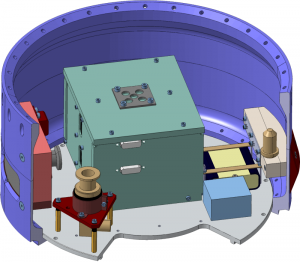The models of the distribution of residual gases in the atmosphere vary widely, for instance the atomic oxygen models provide results differing up to 400%. To predict climate it is important to know the distribution of oxygen in its forms molecular and atomic oxygen as well as ozone more accurately. Also, atomic oxygen has a major influence on space borne objects, as it degradates exposed materials aggressively.

Therefore the MOXA experiment will measure ozone, atomic and molecular oxygen partial pressure, temperature and pressure during the flight. The Institute for Aerospace Engineering at TU Dresden has developed innovative sensors for oxygen and ozone with a very low response time and high measurement accuracy. The atomic oxygen sensors of the FIPEX experiment already performed successful measurements onboard the International Space Station and will be integrated in our experiment in a new, miniaturized form.
The currently developed ozone sensor will be tested by comparing data collected during flight with existing data. In addition, the data of the oxygen measurements can give a hint on the ozone values and will help to verify the functionality of the ozone sensor.
The development of precise sensors for residual gases contributes to the more detailed investigation of the atmosphere. It is crucial to correlate existing, partially contradictive, atmospheric models with new, more extensive data to create a new model which allows a more precise prediction of the distribution of residual gases. This will support atmospheric science and improve the preparation potential of material etc. for long term low earth orbit missions.
The sensors developed at the ILR can also be applied in several other research fields. The oxygen sensor, for example, can be used for respiratory analyses in medical science; the ozone sensor may at some point be used for monitoring the ozone concentration near printers, as too high concentrations can cause health problems.
Due to the interesting higher concentrations of Atomic Oxygen occur above 70km, for Ozone between about 10-50km, we need to provide adequate measuring during the complete REXUS flight. To provide best measurements during high and low atmospheric pressure two different kinds of measurement chambers will be used. One set of sensors will be placed within an inside chamber. The inside chamber is designed for high velocity and high pressures. The outside chamber is protected by a hatch. After the hatch opens the sensors will be directly exposed and will therefore perform measurements of low pressure and subsonic speeds.
The hatch will trigger at above 70km (100 seconds) and expose the outside sensors during the Apogee of the flight. Additional pressure and temperature sensors are included to each Module. The Sensors will be exchanged at module integration before the transport to the Launchpad. Heating to two Sensors will be provided to avoid freezing during transportation. At Launchpad the Sensors will be preheated to their operating temperature. Measurements will be performed after Liftoff and the Hatch will be opened at about 70km height by timeline. At shutdown, all the sensors will be disabled, voltages discharged and go into standby.